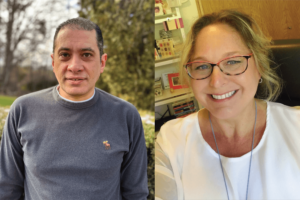 Our mission at Microsoft is to empower every person and every organization on the planet to achieve more. Our Microsoft Digital Employee Experience team lives this mission every day by empowering employees across the organization with inclusive digital and physical experiences.
Our mission at Microsoft is to empower every person and every organization on the planet to achieve more. Our Microsoft Digital Employee Experience team lives this mission every day by empowering employees across the organization with inclusive digital and physical experiences.
Leading our accessibility efforts over the past two years, I’ve seen teams make great progress—not just in those experiences, but also in the culture we’ve created across the organization. It’s energizing when you hear someone share an accessibility tip in a meeting or see the “Accessibility: Good to Go” message in someone’s PowerPoint presentation.
We have continued to evolve the way we incorporate accessibility practices into our employee experiences—from meeting etiquette to the digital experiences that enable our employees to do their best work. And with the recent explosion of generative AI using machine learning to further drive productivity improvements, it’s important we continue to extend these practices to new experiences, so everyone benefits.
We worked with the Accessibility team to create a quick guide of best practices for large, internal meetings like Town Halls that serves as a checklist for administrators, meeting organizers and leaders. It helps us all be consistent on what to do when planning a meeting to help everyone fully participate.
—Michelle Strub, executive communications lead, Microsoft Digital Employee Experience

Following are three practices our teams have learned and do regularly that can be applied across your own organization. Adopting and championing these can increase productivity and higher engagement.
[Learn how to create inclusive content with the new Accessibility Assistant in Microsoft 365. Take our accessibility fundamentals training. Learn about our responsible AI program. Find out about our pursuit of inclusive AI.]
Practice #1: Regularly communicate and model key behaviors for inclusive meetings
Meetings are critical to getting work done, whether it’s communicating priorities, driving alignment, brainstorming ideas, or making decisions. Features in Microsoft Teams and Microsoft 365 help people customize their experience, but we found many people weren’t aware of the options available. And while our accessible events guide gives lots of useful information, we found it was sometimes hard for people to know what to adopt and when.
“We worked with the Accessibility team to create a quick guide of best practices for large, internal meetings like Town Halls that serves as a checklist for administrators, meeting organizers and leaders,” says Michelle Strub, an executive communications lead in Microsoft Digital Employee Experience. “It helps us all be consistent on what to do when planning a meeting to help everyone fully participate.”
It really brought to light the customer pain point by having the employee walk through and share their experience with the tool. I tried to put myself in their shoes by closing my eyes and trying to follow along. That’s when I realized how confusing it was.
—Jaimie Larsen, product manager, Microsoft Digital Employee Experience
Companies can develop their own checklists to increase awareness of important practices, building up adoption over time. While some of these features were initially designed to support individuals with disabilities, we found the following practical tips encouraged everyone to participate and engage effectively.
- Encourage presenters to watch our inclusive presentation skills.
- Share materials in advance and use the accessibility checker in Microsoft Office.
- Use PowerPoint Live to enable features like real-time captions and translation.
- Record meetings so people can catch up later or review to improve understanding.

Practice #2: Build empathy and understanding through storytelling
Creating connections is central to the human experience. We’ve seen employees across Microsoft share their stories, and the stories of others, to improve understanding about why it’s important to create experiences that consider the needs of everyone. Jaimie Larsen, a product manager in Microsoft Digital Employee Experience, was new to accessibility when she met with engineers across her organization to understand their needs and challenges. She quickly realized that the engineers didn’t always understand the impact a poorly designed tool could have on someone’s daily work. She found inspiration to start a quarterly series that featured employees and how they use different tools.
“It really brought to light the customer pain point by having the employee walk through and share their experience with the tool. I tried to put myself in their shoes by closing my eyes and trying to follow along. That’s when I realized how confusing it was,” Larsen says.
Due to this session, Larsen created a stronger understanding of the importance of the work to the engineering team for the specific tool and others were able to learn from it.
It’s been a multi-year journey as we have shared our expertise at Microsoft and worked with ServiceNow to develop practices and processes that continually improve the experiences for our employees.
—Sherif Mazhar, principal program manager, Microsoft Digital Employee Experience
“It was great because we needed multiple teams to do work to make the experience better,” Larsen says. “This session really helped anchor the goal and impact for everyone.”

Practice #3: Create alignment on accessibility with partners internally and externally
We partner with teams across Microsoft and external organizations to deliver employee experiences globally. Using international accessibility standards including Web Content Accessibility Guidelines (WCAG), teams have developed strong partnerships and commitment to ensure that accessibility is included as a key requirement and measure of success. One of these partnerships has been with ServiceNow, where Sherif Mazhar, a principal program manager, worked closely with ServiceNow to align accessibility goals and drive improvements together.
“It’s been a multi-year journey as we have shared our expertise at Microsoft and worked with ServiceNow to develop practices and processes that continually improve the experiences for our employees,” Mazhar says.
Leaders at Microsoft and ServiceNow have aligned on accessibility goals and now review progress quarterly against common goals.
It takes time to build up relationships and expertise when the primary job someone is used to doing is not focused on technology. I’ve found it helpful to explain the impact and show what happens, rather than just talking about an issue. It can be easy for people to get lost if you use too much technical jargon.
—Erika Retikis, principal product manager, Microsoft Digital Employee Experience
Our Microsoft Digital Employee Experience team works with our colleagues in Microsoft Human Resources to build internal and external partnerships that are increasing accessibility awareness and knowledge. Erika Retikis, a principal product manager in Microsoft Digital Employee Experience, has worked with multiple customer companies over the last few years and sees many unique challenges, especially for those companies or teams that aren’t as tech savvy.
“It takes time to build up relationships and expertise when the primary job someone is used to doing is not focused on technology. I’ve found it helpful to explain the impact and show what happens, rather than just talking about an issue. It can be easy for people to get lost if you use too much technical jargon,” Retikis says.

Looking ahead: Artificial Intelligence needs accessibility from the start
As we and other companies look at how artificial intelligence is embedded into different experiences, it will be critical to think about accessibility from the start to ensure that the data and the experiences include everyone. One area of focus is ensuring data sets include a variety of people and situations. We also regularly include employees with disabilities at various product development stages to benefit from their perspective and create more accessible and inclusive experiences.
So, when you are thinking about building and adopting inclusive experiences, you should try and keep the above tips in mind, as well as other best practices included in some of the resources below, to ensure that your employee experiences are created with everyone at the center.

- Learn more about creating an accessibility training program for your team.
- Dive into the latest accessibility fundamentals training course on Microsoft Learn.
- Learn how to create inclusive content with the new Accessibility Assistant in Microsoft 365.
- Take our accessibility fundamentals training.
- Learn about our responsible AI program.
- Find out about our pursuit of inclusive AI.
Want more information? Email us and include a link to this story and we’ll get back to you.
Tags: accessibility, AI and Machine Learning, culture, Microsoft Teams








